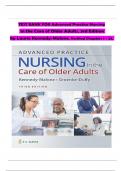, Chapter 1. Changes With Aging |;, |;, |;, |;,
Multiple Choice |;,
Identify the choice that best completes the statement or answers the question.
|;, |;, |;, |;, |;, |;, |;, |;, |;, |;, |;,
1. The major impact ofthe physiological changes that occur with aging is:
|;, |;, |;, |;, |;, |;, |;, |;, |;, |;, |;,
| ;
,
A. Reduced physiological reserve
| ; , |;, |;,
B. Reduced homeostatic mechanisms
| ; , |;, |;,
C. Impaired immunological response
| ; , |;, |;,
D. All of the above
| ; , |;, |;, |;,
2. Thestrongest evidence regarding normalphysiological aging isavailable
|;, |;, |;, |;, |;, |;, |;, |;,
through:
|;,
A. Randomized controlled clinical trials
|; , |;, |;, |;,
B. Cross-sectional studies
| ; , |;,
C. Longitudinal studies
| ; , |;,
D. Case control studies
| ; , |;, |;,
3. All ofthe following statements aretrue about laboratory values in older
|;, |;, |;, |;, |;, |;, |;, |;, |;, |;, |;,
adults except:
|;, |;,
A. Reference ranges are preferable
| ; , |;, |;, |;,
B. Abnormal findings are often due to physiological aging |;, |;, |;, |;, |;, |;, |;,
C. Normalranges may not be applicable for older adults |;, |;, |;, |;, |;, |;, |;, |;,
D. Reference values are not necessarilyacceptable values
| ; , |;, |;, |;, |;, |;, |;,
4. Biochemical individualityis best described as: |;, |;, |;, |;, |;,
A. Each individual’s variation is often much greater than that of a larger
| ; , |;, |;, |;, |;, |;, |;, |;, |;, |;, |;, |;,
group
B. The unique biochemical profile of a selected population
| ; , |;, |;, |;, |;, |;, |;, |;,
C. The truly “normal” individual—falling within average range
| ; , |;, |;, |;, |;, |;, |;,
,
, B. | ; , What the body does to the drug
|;, |;, |;, |;, |;, |;,
C. The effect at the site of action and the time and intensity of the
| ; , |;, |;, |;, |;, |;, |;, |;, |;, |;, |;, |;, |;, |;,
drug
|;,




